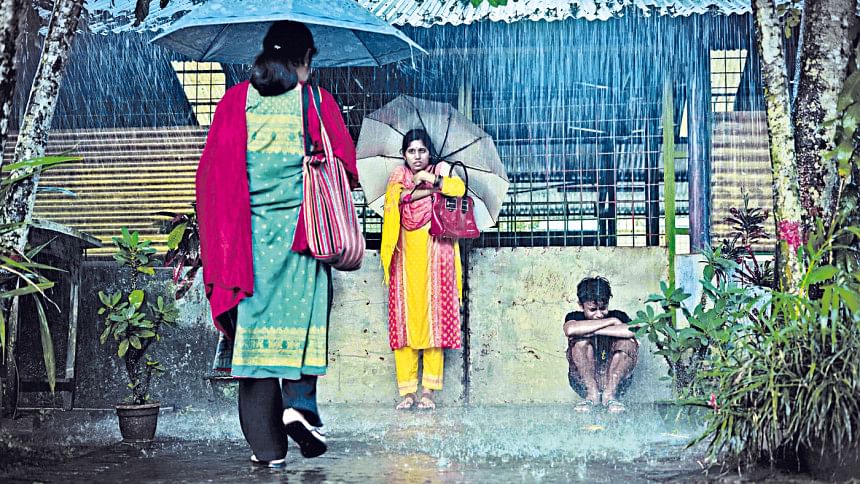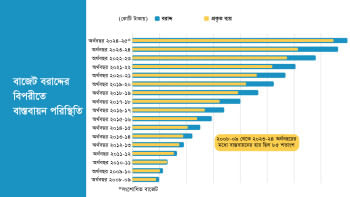Preserving Indigenous languages through films

In a remote Garo village, an elderly Indigenous couple lives by themselves. One day, they receive two letters—one from the forest department and another from their grandson. Their neighbour's son reads the letters to them, revealing that their grandson, who works as a firefighter in Chittagong, will visit them the next day. Overjoyed, the couple prepares for his arrival. The old man sets out to catch fish and his wife prepares traditional food, while they witness their neighbours leaving the village, forced to migrate to India due to forest-related litigations. Their grandson, however, never arrives. Unbeknownst to them, he has died in a fire rescue mission. Still, the elderly couple waits for days, longing for their grandson, even as their village slowly empties.
This poignant scene is from a short film called Bikinggri Etchaluk (A snail without a shell). Entirely in the Mandi/Garo language, the film beautifully captures the vulnerability and simplicity of Indigenous life. Its title metaphorically represents the fragile state of Indigenous people, much like a snail without a shell—unprotected, exposed. The film, created in 2023 by Mohin Rakhaine, a Kazi Nazrul Islam University graduate, has been recognised at national festivals and selected for international screenings, including the New York Asian Film Festival, International Film Festival of South Asia Toronto, Dharmashala International Film Festival and Diaspora Film Festival.
Films like this, created by young people from the Indigenous community, are a rarity in Bangladesh, where storytelling in Indigenous languages through cinema is still an uncommon practice. Yet, in a country where many Indigenous languages are vanishing, films like Bikinggri Etchaluk create ripples, if not waves, in efforts to preserve these languages. According to the International Mother Language Institute's latest survey, 14 Indigenous languages in Bangladesh are on the verge of extinction. The reasons are clear—lack of patronage, lack of institutional support, and an environment that fails to nurture these languages.
Among all art forms, film is one of the most powerful mediums for impact. A visual narrative can reach audiences far and wide, making Indigenous languages more visible and relevant. When characters converse in Indigenous tongues on screen, it leaves lasting impressions. Language is meant to be spoken and practised, and films provide that space, ensuring its endurance. Indigenous cultures, historically rooted in oral traditions, rely heavily on storytelling. The Garo language is one such example, predominantly passed down orally rather than through writing. Oral storytelling is central to their linguistic heritage. By documenting folktales, myths, and historical narratives in Indigenous languages, films help preserve these traditions, ensuring they are not lost with time.
However, preserving Indigenous languages through films is not without challenges. Many Indigenous youths are fluent in speaking their mother tongue but struggle to read or write it. Others understand the language but lack fluency in speaking. This loss is largely due to the absence of an ecosystem that fosters language learning and usage. Mohin Rakhaine, the director of the aforementioned film, despite being a Rakhaine himself, admitted that while his parents are fluent in reading the Rakhaine script, he sometimes faces difficulties decoding its written format. He learned to read and write his mother tongue at home, not in school. He acknowledges that there is little motivation for Indigenous youth to learn their languages, and films featuring these languages are very few. His goal is to create more films in Indigenous languages, particularly in Rakhaine, hoping that the movies would inspire future filmmakers.
There are many significant logistical challenges in making Indigenous-language films. Directors often struggle with dialect accuracy and pronunciation. Finding skilled art directors and costume designers familiar with Indigenous aesthetics is also difficult. The biggest challenge, however, is finding actors who can speak Indigenous languages fluently while delivering strong performances. Many Indigenous languages in Bangladesh have been influenced by Bangla, creating linguistic hybrids that distort film authenticity.
Fidel Drong, a Dhaka University graduate and filmmaker, faced similar issues while directing Umbrella, a Garo-language film. Throughout different scenes, he incorporated Bangla due to linguistic limitations. Another challenge arose in choosing between Abeng and Achik, the two major Garo dialects. Plainland Garos typically use Abeng, while those in the hills speak Achik. Fidel ultimately settled on Abeng to connect with Bangladeshi Garo audiences, blending Bangla and Garo words to maintain accessibility.
The producer of Umbrella, Antony Rema—also a member of the popular Indigenous band Madol—spoke about the difficulties of making Indigenous films. He pointed out that Garo people have Serenjing, a unique musical storytelling tradition combining mythological, historical, and social themes through songs, dialogues, and dramatic expressions. However, few people today can perform Serenjing because it is no longer actively practiced. This decline mirrors the gradual loss of Indigenous languages. Antony recalls watching Khabak Ni Khabak (Love of My Life), a Garo-language romantic film directed by Tiresh Nokrek, in his childhood. The film, with its beautiful Garo songs, changed his perspective on Indigenous-language cinema. However, Khabak Ni Khabak was never archived, and today, no official record of the film exists.
The absence of proper archiving is another major concern. Indigenous filmmakers and festival organisers have repeatedly raised this issue. Currently, no central authority systematically collects and preserves Indigenous films. According to Indigenous directors, there are only about 20 to 25 Indigenous-language films in Bangladesh. Funding remains a major obstacle. Filmmaking requires significant financial resources, which are often beyond the reach of Indigenous filmmakers.
Despite these barriers, efforts are being made to promote Indigenous cinema. The Hill Film Festival in Bangladesh, held every two years in Rangamati and Dhaka, serves as a platform for screening Indigenous films. Around 300-400 people attend the festival, which receives support from organisations like Drik and the Goethe-Institut Bangladesh. However, according to Festival Director Adit Dewan, there simply aren't enough Indigenous films to screen because of the financial obstacles Indigenous directors face.
The Bangladesh government can play a crucial role in supporting Indigenous-language films. The information and broadcasting ministry, which provides grants for various film productions, could allocate specific funding for Indigenous-language cinema. While there are some documentaries on Indigenous people, there is a significant lack of Indigenous-language feature films. Young Indigenous filmmakers must be supported through funding, training, and workshops to create high-quality films that authentically represent their communities. Additionally, Indigenous films should be promoted through television, online streaming platforms, and national film festivals.
There should also be a shift in mindset regarding Indigenous films. They should not be viewed as controversial or anti-state. Mor Thengari (My Bicycle), considered Bangladesh's first Chakma-language film, faced censorship issues. The 64-minute film began shooting in 2012 and had its first premiere in 2014 at a festival in Dhaka. Directed by Aung Rakhine, the film was submitted to the Bangladesh Film Censor Board in May 2015, only to be banned shortly after, allegedly because it did not portray security forces in a favourable light in the context of the Chittagong Hill Tracts conflict.
Despite the ban, the film gained international recognition, earning accolades at Tallinn Black Nights Film Festival in Estonia, Russia's Silver Akbuzat International Festival of National and Ethnic Cinema, and the Kolkata People's Film Festival, among others. In a bold act of resistance, a group of like-minded young filmmakers, students, and educators organised an independent screening of Mor Thengari alongside Michiler Mukh, a film by director Zakir Hossain Raju, at Suhrawardy Udyan in August 2024. Such films should be encouraged rather than restricted, as they provide valuable insights into Indigenous lives, struggles, and cultures.
The United Nations declared 2019 as the International Year of Indigenous Languages, which led to the proclamation of the International Decade of Indigenous Languages (2022–2032). This decade-long initiative aims to safeguard Indigenous languages by ensuring they are actively spoken and passed down to future generations. Promoting Indigenous films is a vital part of this mission, as cinema serves as an accessible and engaging tool for language preservation and cultural celebration.
Indigenous people have long been revered as exceptional storytellers. Their oral traditions carry the history, wisdom, and values of their cultures. These stories are not just narratives; they are the heartbeat of their communities, preserving identities and connecting generations. In the modern era, one of the most powerful mediums for storytelling is film. By translating Indigenous tales into cinema, filmmakers have the opportunity to reach broader audiences, ensuring that these narratives endure and thrive. Films not only capture the essence of Indigenous languages but also elevate their visibility, preserving them in ways that transcend geographical and cultural boundaries.
As one of the most influential storytelling tools today, film provides a dynamic platform for Indigenous voices. Indigenous stories must be told, and their languages must be heard. To keep these languages alive and vibrant for future generations, Indigenous filmmakers must be supported, and their work must be celebrated. Language, after all, is the soul of a culture. If we fail to preserve it, we risk losing an irreplaceable part of our collective human heritage.
Mathews Chiran is a development practitioner from the Indigenous Mandi/Garo community.

 For all latest news, follow The Daily Star's Google News channel.
For all latest news, follow The Daily Star's Google News channel. 



Comments